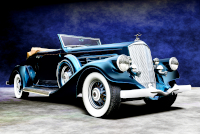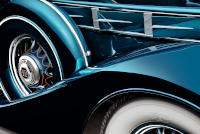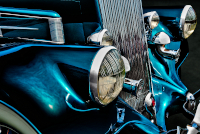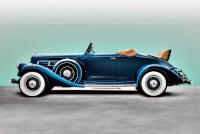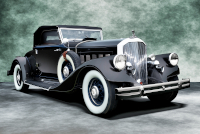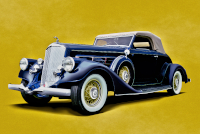Location:
Elegance at Hershey, 2015
Owner: Sam Lehrman | Palm Beach, Florida
Prologue:
Since 2015 this Pierce-Arrow changed hands. We note the owner of record at the time of photography.
I prepared this profile in concert with the 1935 Model 845 Convertible Coupe Roadster—good for comparison between the straight-8 and V-12 variants. But this sparkling roadster gives us opportunity to comment on Chief Engineer Karl Wise, suggesting a swansong in curvaceous teal-metallic costume.
For that matter, I pumped the contrast and did not worry about whether the product appears too fabricated. More than I expected, I like the design. And I believe the Model 1245 Convertible Coupe Roadster is perhaps a better representation of the high-classic V-12 Pierce-Arrow than its closed-coupe Silver Arrow brethren (meaning the production cars). If we trace the design to the Model 1242, the first of the V-12 roadsters, we find continuity in this exclusive, open-car concept. These are not bread-and-butter offerings for a marque so conservative as Pierce-Arrow, but they are attention-grabbing. And with purpose. So of course this Model 1245 is the 1935 Chicago Auto Show car.
- - - - - - - - - -
► Image Source: Nikon D750 (24.3 MP)
References:
- Ralston, Marc. "Pierce-Arrow" A.S. Barnes & Co., Inc., San Diego, CA. 1980, page 180, 194, 232
- Automobile Quarterly, Volume 28, Number 4, Fourth Quarter 1990, "The Last Years of Luxury" by John C. Meyer III, The Kutztown Publishing Company, Inc., Kutztown, PA, page 95, 98
- Automobile Quarterly, Volume 6, Number 3, Third Quarter 1968, "Pierce-Arrow: An American Aristocrat" by Maurice D. Hendry, The Kutztown Publishing Company, Inc., Kutztown, PA, page 263, 275
Profiling the 1935 Model 845 Convertible Coupe Roadster, we note Pierce-Arrow's dire financial circumstances, how the company repeated its offerings in lieu of the updates luxury automakers typically unveiled each year, and how numbers fell to roughly one-half of 1934 production. And yet these circumstances make 1935 versions of the classic Pierce-Arrow catalogue comparatively rare. Added to rarity, this Convertible Coupe Roadster is a V-12 example, and it is also the car Pierce-Arrow displayed at the 1935 Chicago Auto Show.
Karl Wise and the Swansong Pierce-Arrow V-12
Without repeating too much of the 845's introduction to 1935, the 1245 is better representative of Chief Engineer Karl Wise, maybe in a swansong respect, as he will leave Pierce-Arrow this year. Departing along with Vice President Roy Faulkner, Wise built the classic era Pierce-Arrow as David Fergusson had built the brass era Pierce-Arrow, with indisputable technical integrity. Only that the rest of the American auto market has since caught up with Pierce-Arrow does the marque's slim margin of superior refinement matter so little. From a design and engineering standpoint, and also considering the people involved, these 1935 models are the last of the high-classic Pierce-Arrow cars produced as of 1933. Such a short period, these brief years of independence follow the Studebaker partnership and precede the final redesign of 1936, which will see the marque to its death in 1938.
But for a moment, Karl Wise assumed the lead and developed Pierce-Arrow's V-12, a heroic achievement marked by land speed records and longevity. First came Abner Jenkins and 14 Federation Internationale de l'Automobile (FIA) endurance records, a genuine claim to fame not unlike Pierce-Arrow's dominance of the Glidden Tour after the turn of the century. So much the better, though the Great Depression offset any calculable enthusiasm on the part of the public. So the Model 1245 Convertible Coupe Roadster is a strangely luxurious vessel with an over-engineered, over-built heart. And the design is nothing so ostentatious to belie that potential. Instead, as a show car, this roadster is what Pierce-Arrow used to convince the public of what the best car available could be.
Admitting as I have that the production Silver Arrow is rather deficient in its delivery of the 1933 Silver Arrow show car's promise, the Convertible Coupe Roadster is I think better in its execution. This much is opinion, but the 1934-35 roadster design is a proper update of the 1933 roadster, which itself is a special car, and of which, like the 1933 Silver Arrow show car, there are only three remaining. In this sense, while we trace the Silver Arrow's waning influence from show car to production variant, we can also trace the steadiness of the Convertible Coupe Roadster alongside. The style loses nothing of its charm, but instead perpetuates the exclusivity and excellence of that 1933 roadster design.
The second note on Karl Wise is that, latterly, Seagrave will purchase Pierce-Arrow's engineering remnants from receivership in 1938, and then produce the V-12 for its fire engines for over four decades. In all definitions of over-built engineering, a land speed record car that gives its drivetrain to a fire engine meets any criteria. Now of course I've dived into hyperbole, but it is important to provide proper explanation of why a car that looks so beautiful is also so significant. The answer might be framed in representational terms, but this Model 1245 is the end of an era.
Motor: 7,570 cc (462 cubic inch) 80° V-12, cast-iron block | 88.9 mm x 101.6 mm (3½" x 4")
Valvetrain: L-head, 2 valves per cylinder, with self-adjusting hydraulic tappets
Aspiration: Stromberg dual downdraft carburetor
Power: 175 bhp @ 3,400 rpm
Drivetrain: 3-speed gearbox with freewheeling, rear-wheel drive
Front Suspension: solid axle, semi-elliptic leaf springs, friction dampers
Rear Suspension: live axle, semi-elliptic leaf springs, friction dampers
Architecture: steel ladder frame chassis with steel body over wood frame
Wheelbase: 3,530.6 mm (139 inches)
Etymology:
In 1935, the three Pierce-Arrow models adopt a '-5' nomenclature, the first two moving from the Model 840A to the Model 845 (the straight-8), and from the Model 1240A to the Model 1245 (the Karl Wise V-12). Of course the already improperly named 1934 Model 1248A (V-12 on the long-chassis 147-inch wheelbase) becomes the Model 1255. But the formula is the same for all—add '-5' to the end for 1935.
The Convertible Coupe Roadster body style dates back to 1929. In this sense, 'convertible coupe' is adequate, whereas sales material used the roadster terminology and added "with rumble seat" to be thorough. Pierce-Arrow gilded its model names, updating numbering systems year over year for the sake of novelty, preferring long-winded titles in lieu of simple description. In this profile, we also reference the Model 1242 Convertible Coupe Roadster of 1933, which is the first of the V-12 roadsters.
Figures:
Ralston notes that Pierce-Arrow produced 875 total cars in 1935, roughly half of its 1934 production. There appear to be a handful of Convertible Coupe Roadsters from 1934 and 1935, both straight-8 and V-12 examples, which is not a helpful comment, but there remains no record of production according to body style from these latter years.
Identification 1935: Minor 1935 Pierce-Arrow Styling Updates
With financial distress, the only update requiring new tooling is the bonnet side, which places three vents in a single streamlined chrome frame. Less complicated are the convex headlamp lenses, which give the lights a modernized, tubular appearance. Speaking of the Model 845 Convertible Coupe Roadster, we noted how Ralston called attention to the loss of the classic look with the re-styled 1934 cars. These 1934-35 cars are certainly not as square, but belong to a forward-thinking design concept. These designs begin trends that will resurface in the late 1940s after World War II; they are shapely bodies gradually drawing the fenders higher and the wheel shrouds into more complete surrounds.
And yet what is interesting about the 1934-35 Pierce-Arrow is that the front valance does not yet cloak the tyres. For instance, Packard has already lowered the front edge of the fenders almost to the guard by 1934, and by 1935 completely the fenders completely shroud the tyres. But in 1935, Pierce-Arrow maintain a valance at the level of a 1933 Packard. This lag in design pace speaks to Pierce-Arrow's financial circumstances, but also allows a more classic sense of style to linger a moment. By 1936, in its final re-styling, Pierce-Arrow will match Packard and the classic look Ralston opined for will disappear.
845 Comparison: Examining the Model 845 and Model 1245 Convertible Coupe Roadsters.
The V-12 Model 1245 is identical to the Model 845 except for optioning. In the case of the two cars we compare here, the difference is painted wire wheels on the straight-8 as opposed to Budd cast-steel artillery wheels on the V-12. For this show car, the steel artillery design works best, allowing for an exact color match with the body, along with pinstripe accents. (Note that the Model 845's painted chrome vent frames appears to be a feature specific to that vehicle.)
Profile Proportions: Balance in the Rumble Seat Design
Whereas we discussed with the Model 845 how the tail predicts heftier shapes of the late 1930s and 1940s, opening the rumble seat interrupts the lines and tempers the tail-end girth. The cabriolet cover, leather guards, and upright seat also arrests the linearity, (does something with all that space underlined by the body binding). Although it is the shortest of Pierce-Arrow chassis, 139 inches is still considerable for a two-door roadster. But with the large hatch open at the back, we can see how the car makes use of the space afforded by this platform, seeing how it accommodates extra passengers. Perhaps it is a trick of newer image stock and better equipment, but the Convertible Coupe Convertible in top-down form looks better proportioned than with the top up. Another interesting feature—one common to Pierce-Arrow design as of 1934—the doors hinge conventionally, but the door handles are reversed. This touch is subtle but effective, and stands out as we look at the broadside perspective.
Last Updated: Mar 26, 2025

